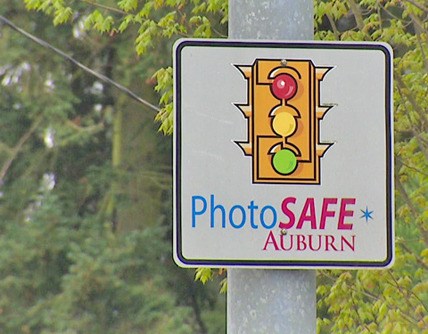Violations at red-light, photo-enforced intersections and school zones continue to drop, according to the Auburn Police Department’s latest report card on the program, “Photosafe Auburn, Third Quarter Report, Jan-Sept 2008 through 2012.”
“Good, positive results,” Bill Peloza, chairman of the Municipal Services Committee, said Monday after learning about the latest numbers on the program.
The City spends about $180,000 every year to Arizona-based vendor RedFlex Traffic Systems to keep it going and is now spending more money than it’s taking in.
The City launched the program on June 30, 2006 at two intersections: Auburn Way South and 4th Street Southeast; and Auburn Way South and M Street Southeast. It added Harvey Road and 8th Street in December of that year.
Today the program also numbers school zone safety cameras for Mt. Baker Middle School and in the school safety zones of Chinook, Dick Scobee, Lea Hill and Arthur Jacobsen elementaries.
The data show that over the third quarters of the years 2008-2012, the percentage of red-light violations, that is, the total number written by officers as opposed to actual infractions issued, dropped as follows:
• Auburn Way South and 4th, southbound, down 42.5 percent, northbound, down 56.3 percent
• M Street and Auburn Way South, westbound, down 62.6 percent, northbound, down 76.9 percent
• 8th and Harvey, down 64.3 percent
• Total: down 54.5. percent
The total number of third quarter infractions actually issued is down 17.42 percent 2008. Officers who review the video clips supplied by RedFlex may decide not to issue infractions based on a number of reasons, including unreadable or obstructed plates, emergency vehicles, inclement weather and the officer’s own discretion.
The third-quarter data for school zone speed enforcement is as follows:
• Dick Scobee, westbound down 80.5, eastbound 59 percent
• Chinook, eastbound 75.9 percent, westbound 76.4.
• Mt. Baker, westbound down 72.5 percent, eastbound 82.7
For the years 2010 and 2012, the only years for which school zone data for the newest cameras is available, the numbers are as follows: Lea Hill Elementary southbound up 60.3 percent, northbound up 33.3; and Arthur Jacobsen Elementary, southbound down 30.7, northbound down 11.9.
City officials say the primary goal is to improve traffic safety through reduction of red-light violations and associated collisions and to reduce speeding in designated school zones.
City officials have taken revenue from the program left over after all expenses are paid and dedicated it to other areas of the city under the umbrella of traffic calming. Cameras cannot be placed at every intersection and along every stretch of road.



